This ragù bianco (Italian white Bolognese sauce) is rich, savory, and creamy without tomatoes. A slow-simmered white meat sauce made with wine, broth, and Parmigiano Reggiano— authentic, comforting, and unforgettable. Perfect for a cozy Italian dinner at home.
If you like this recipe, you’ll also enjoy my Creamy Sausage Pasta and my Creamy Saffron Pasta.

This article contains affiliate links which supports us at no extra cost to you.
Jump to:
The first time I made ragù bianco, I was surprised by how different it felt from the tomato-based Bolognese I grew up with. My husband, who trained as a chef in Northern Italy, introduced me to this dish, and I remember watching him build layer after layer of flavor.
It begins by starting with the soffritto, deglazing with wine, and finishing with broth and milk until the sauce turned silky. Instead of tomatoes, the flavors are delicate but deep, the kind that makes you want to linger at the table for one more bite.
Now, I make this white ragù whenever I want something comforting but elegant. It’s the dish I serve friends when they come for dinner, and the one I crave on Sundays when I have the time to let it simmer low and slow, just like my nonna used to say: ragù should never be rushed.
There’s nothing quite like spooning this creamy meat sauce over fresh tagliatelle or pappardelle; it feels like a hug from the kitchen.
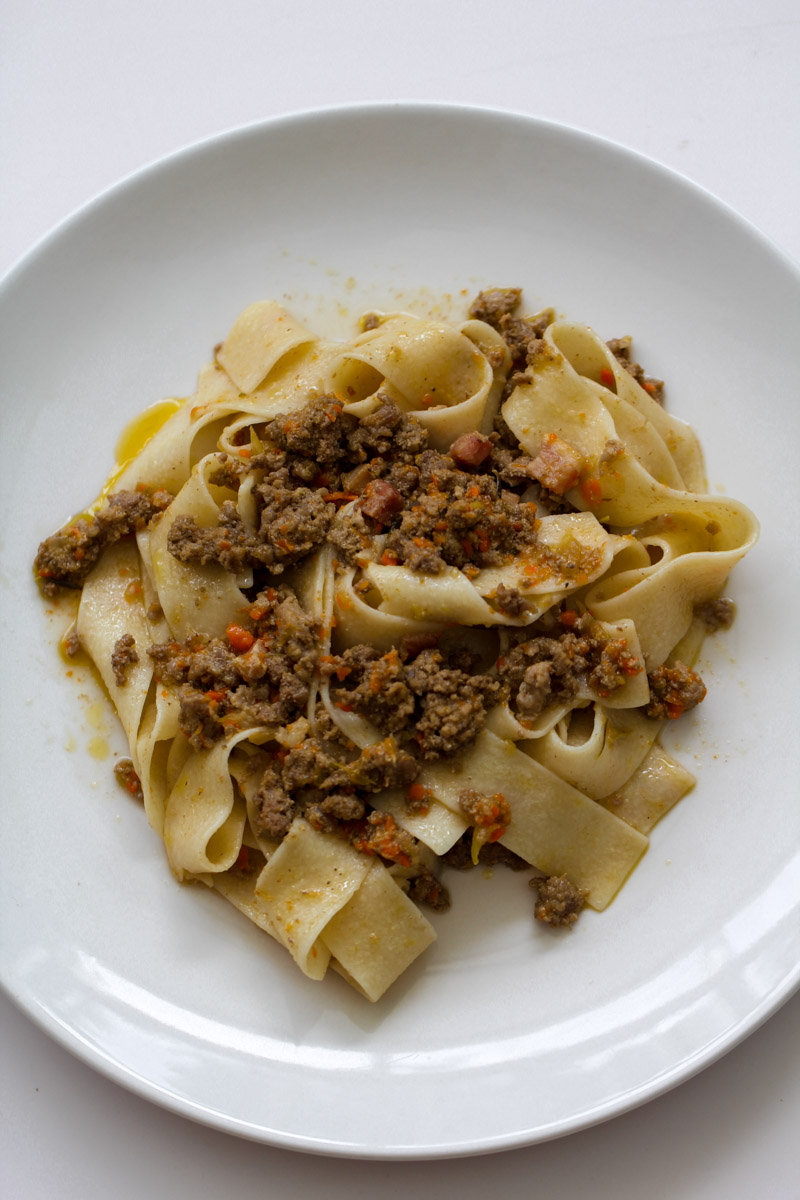
Ingredients to make this ragu'
- Soffritto: This classic trio of finely diced celery, carrot, and onion forms the flavorful base for any good ragù. I like to use Sweet or Vidalia onions. You could use whatever onion you prefer.
- Pancetta: An optional part of sauce, but adds richness and extra flavor to the sauce that can't be surpassed. I now find containers of it at most markets already diced up.
- Ground beef chuck: I like to use 20% fat, but you could use whatever you find.
- Pork sausage: not spicy, casing removed. You could also use ground pork.
- White wine: Be sure to use a wine you would actually drink (your could use Rose' or even a Prosecco). If you don't have any wine on hand, use broth (or stock)
- Unsalted chicken stock or broth: Be sure to use low sodium. I like to use my homemade broth, as it adds a richer flavor to the sauce.
- Whole milk: This is part of the creamy part of the sauce and it gets added in stages
- Dried sage: I used fresh sage from my garden, but you could use even dried sage.
- Dried rosemary: I used fresh rosemary from my garden, you could use dried if you have that on hand.
- Bay leaf: The bay leaf adds a great flavor to the sauce.
- Freshly ground nutmeg: The fresh nutmeg adds a great dimension to the sauce.
- Sea salt: Start with a bit and check seasoning in different stages. The pancetta and sausage will be salty.
- Freshly ground black pepper: Start with a bit, add more to your taste
- Lemon rind: Optional...use organic. The lemon rind gives the sauce a pop of freshness.
- Dried pasta: I prefer to use pappardelle, tagliatelle, or rigatoni (fusilli or spaghetti could also work)
- Grated Parmigiano-Reggiano: Sprinkle on some at the end when serving. You could also use grated Grana Padano. I do NOT recommend using PARMESAN. It is not authentic in Italian cooking.
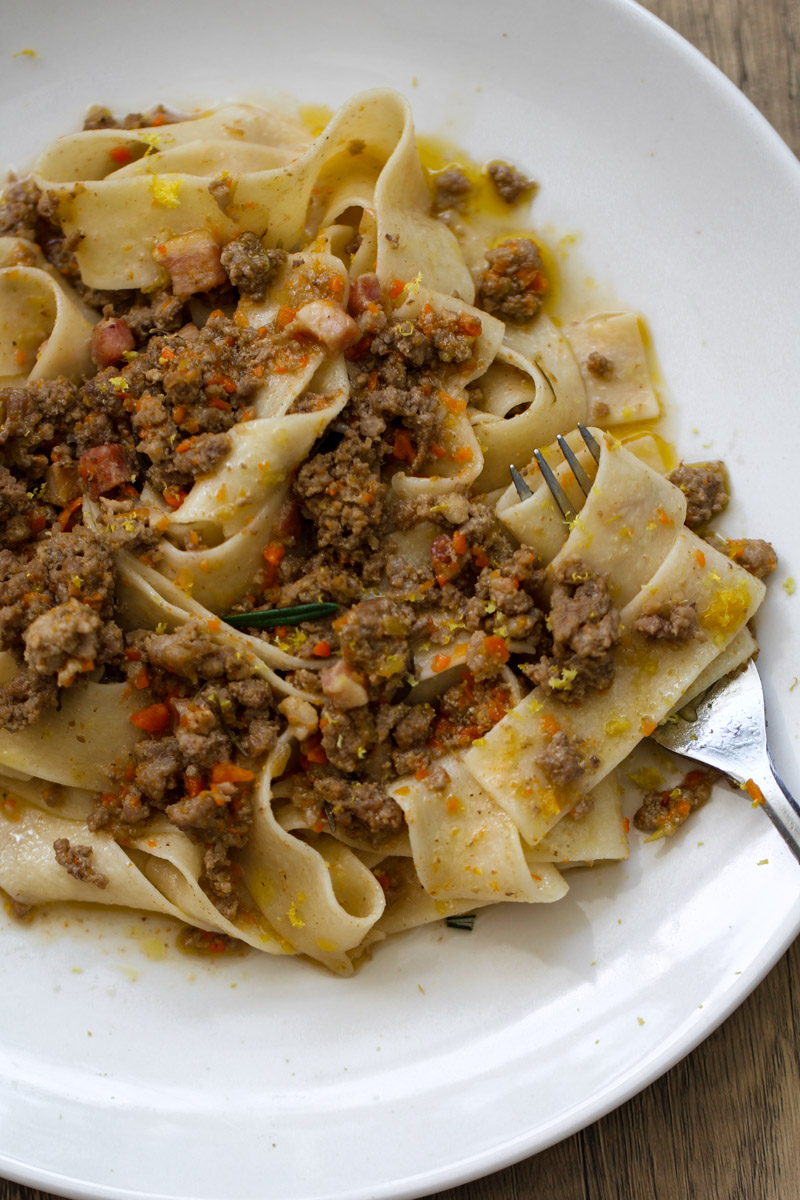
How to make ragu' bianco
Here is how to make this sauce (the full recipe is below!):
Gather all your ingredients.
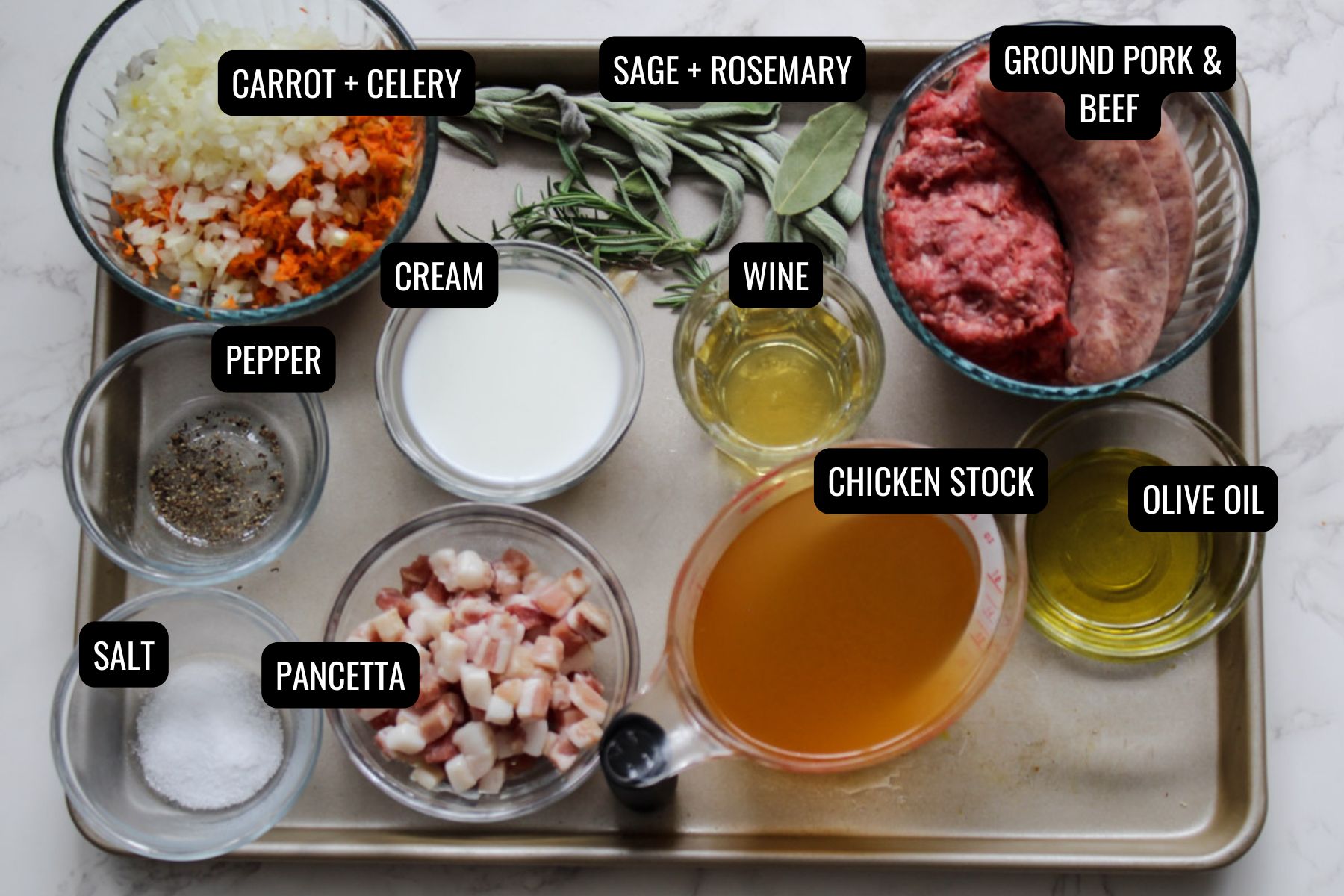
- Before beginning recipe: To make the soffritto, add the chopped onion, celery, and carrot to a food processor and pulse until finely chopped. If you prefer, you can also chop everything by hand with a sharp knife.
- Step 1: Sauté: In a medium size saucepan or a Dutch oven, heat the oil on medium heat. Add the soffritto (carrots, celery, and onions) and cook for about 7 minutes, until the vegetables soften (you aren't browning them). Add a pinch of salt and black pepper.
- Step 2-3: Pancetta: If you would like to use diced pancetta, add that in now (totally optional). Keep stirring frequently.
- Step 4-5: Cook beef + sausage: Add in the ground beef and sausage(you could do ground beef and ground pork). Break up any large lumps and cook until the meat is no longer pink, about 10 minutes.
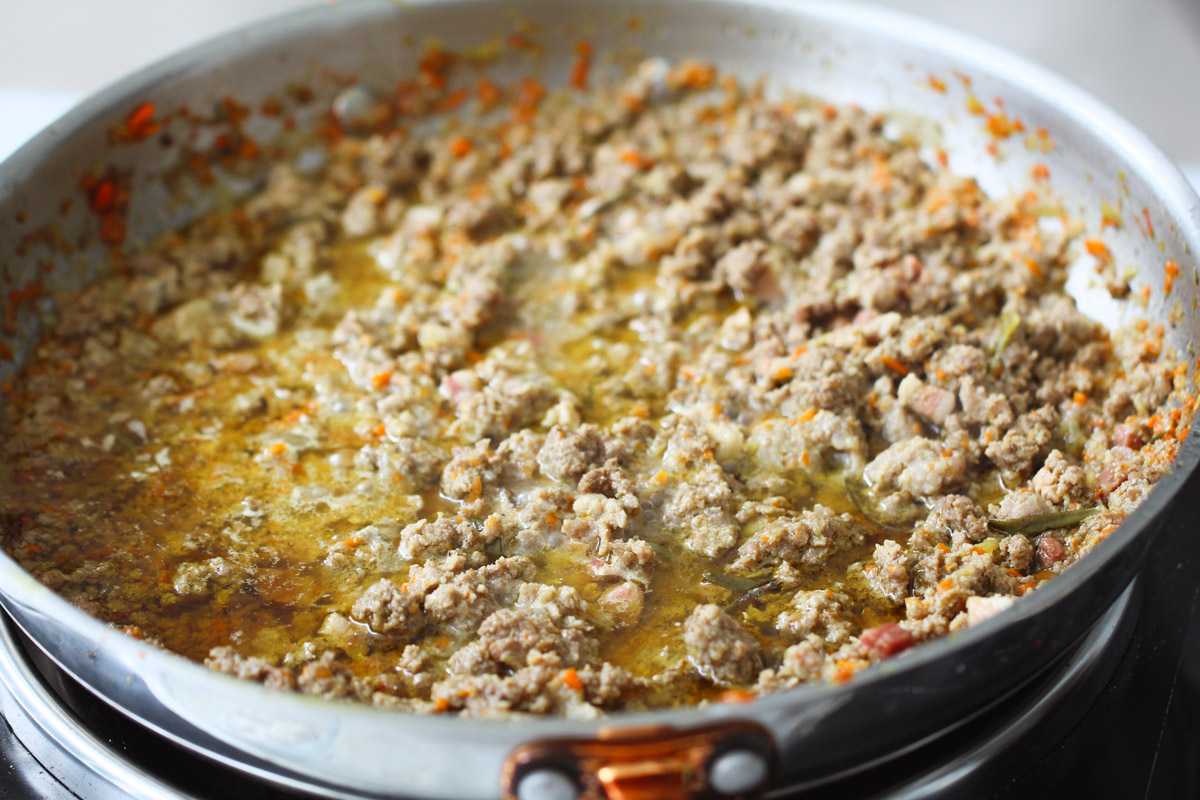
- Step 6: Add herbs and season: Add in the herbs and nutmeg (if you are using) and stir to combine. Add in the wine and stir to combine. Let the wine reduce.
- Step 7 + 8: Add bay leaves + season: Check the flavor and season with a little bit more of salt and pepper, if needed. Don't forget to keep coming back to check the sauce and stir so the sauce doesn't stick to the bottom of the pan. Also, it may be thickening up and you'll have to add some water to it to loosen it up a bit. I simmer my ragu for about about 1½ to 2½ hours.
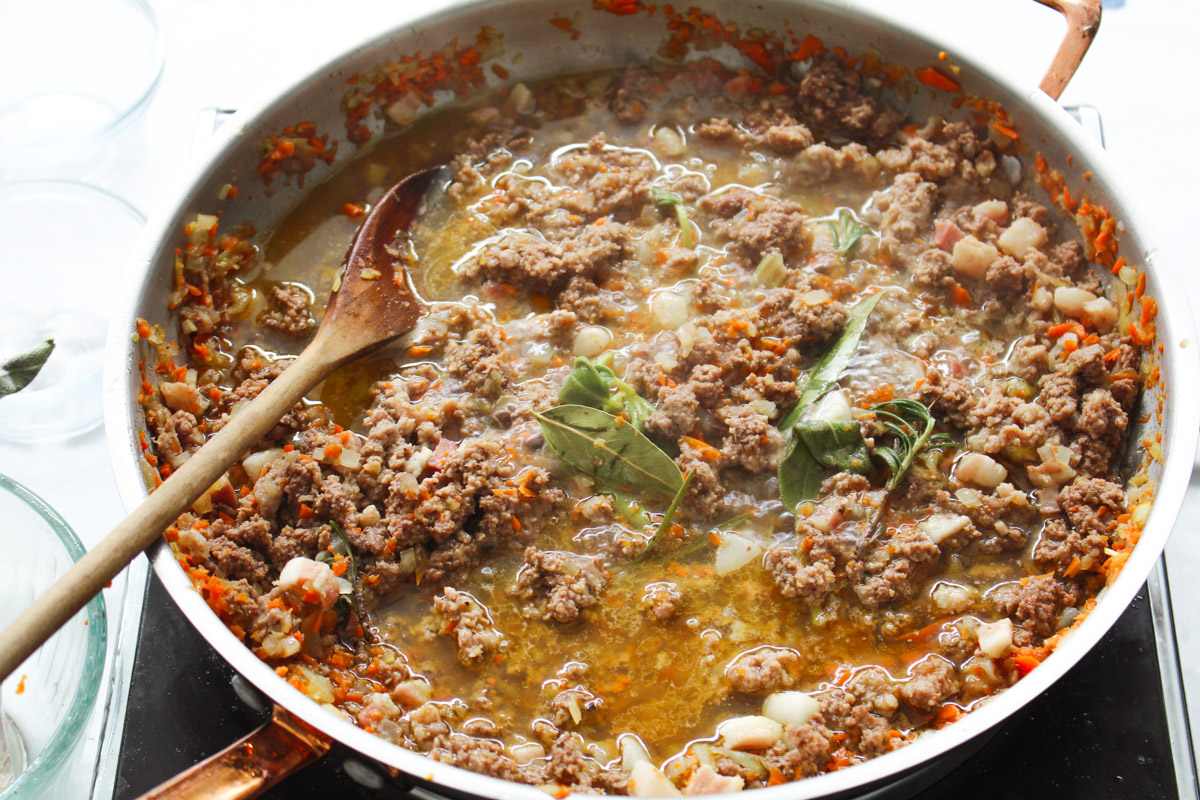
- Step 9: Add milk + stock: Add 1 cup of chicken stock (or broth) and about ⅓ cup milk. Cook over medium low heat until the sauce thickens, which could take about 1½ to 2½ hours stirring every 20 minutes. Make sure the sauce is not boiling, it's supposed to be a low simmer.
- Season: Check the flavor and season with a little bit more of salt and pepper, if needed. Don't forget to keep coming back to check the sauce and stir so the sauce doesn't stick to the bottom of the pan. Also, it may be thickening up and you'll have to add some water to it to loosen it up a bit.
- Simmer: I simmer my ragu for about about 1½ to 2½ hours.Simmer the sauce partially covered for about 30 minutes, giving it a stir once or twice as it cooks. If it starts to look a little dry, pour in a splash of the remaining chicken stock to keep it silky.
- Add rest of stock + milk: Stir in the remaining chicken stock and an extra ⅓ cup of milk. Let it simmer for another 30 to 40 minutes, adding a splash of liquid as needed to keep the sauce creamy and thick—not dry and crumbly, but not too liquidy either.
- Step 10: Cook pasta: (no photo in the collage for this )Once the ragù has been simmering for 1 ½-2 hours, start cooking the pasta. Bring a large pot of well-salted water to a boil and cook the pasta al dente (check the timing on your pasta box and time it). Drain it, making sure to reserve some of the pasta water.
- Add last bit of milk: (no photo for this )While the pasta cooks, stir the final ⅓ cup of milk into the ragù. Give it a good stir and taste for seasoning—I usually add a little more salt at this stage, if it's needed. Remove the bay leaf. You will be serving with Parmigiano Reggiano, so you don't want it too salty.
- Optional: After you've added in the broth and milk, you could transfer the sauce to a slow-cooker and let it simmer on high for 3 hours or low for 6 hours.
- Serve: Combine the pasta with heated sauce. Be sure to stir and coat the pasta. ENJOY!
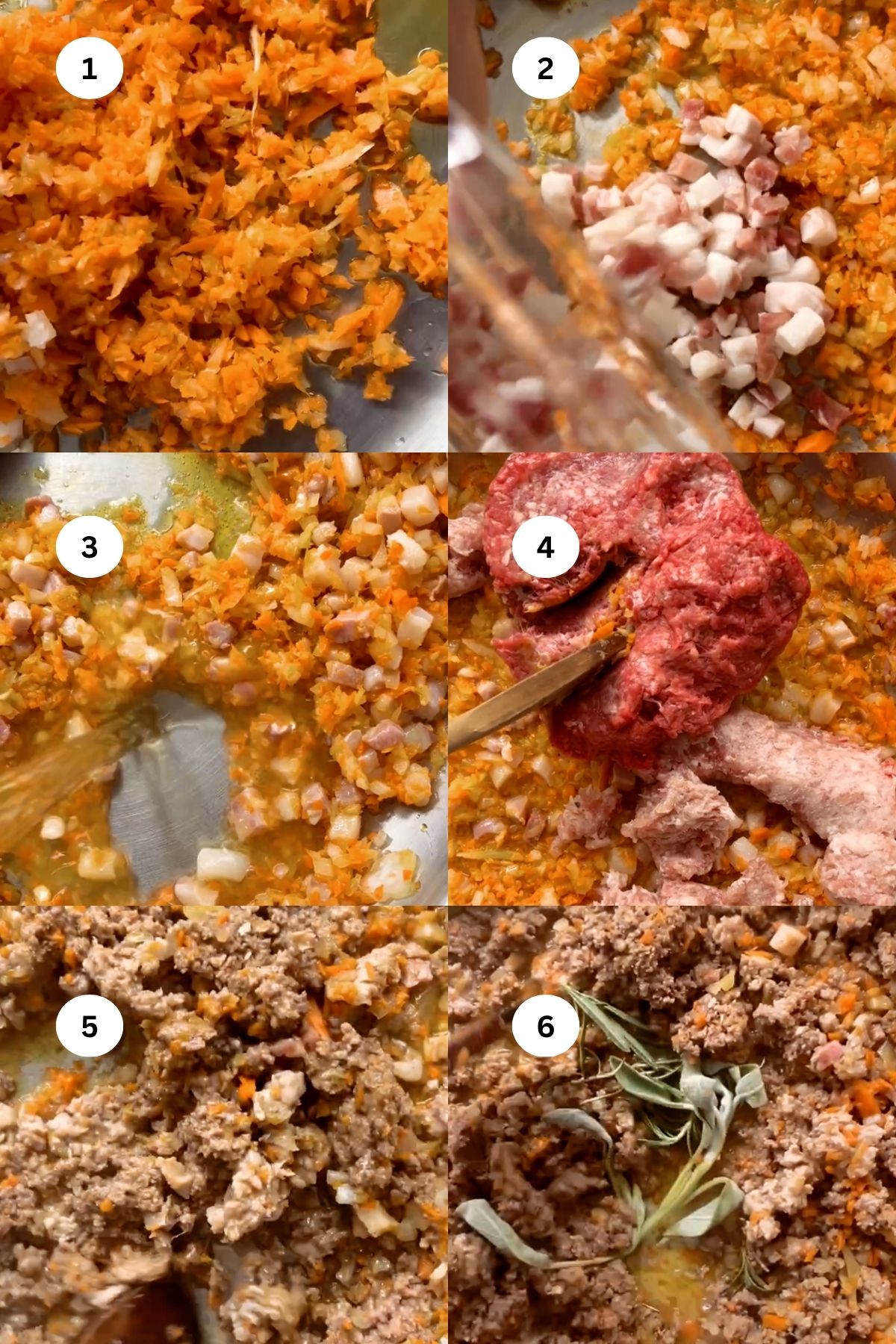
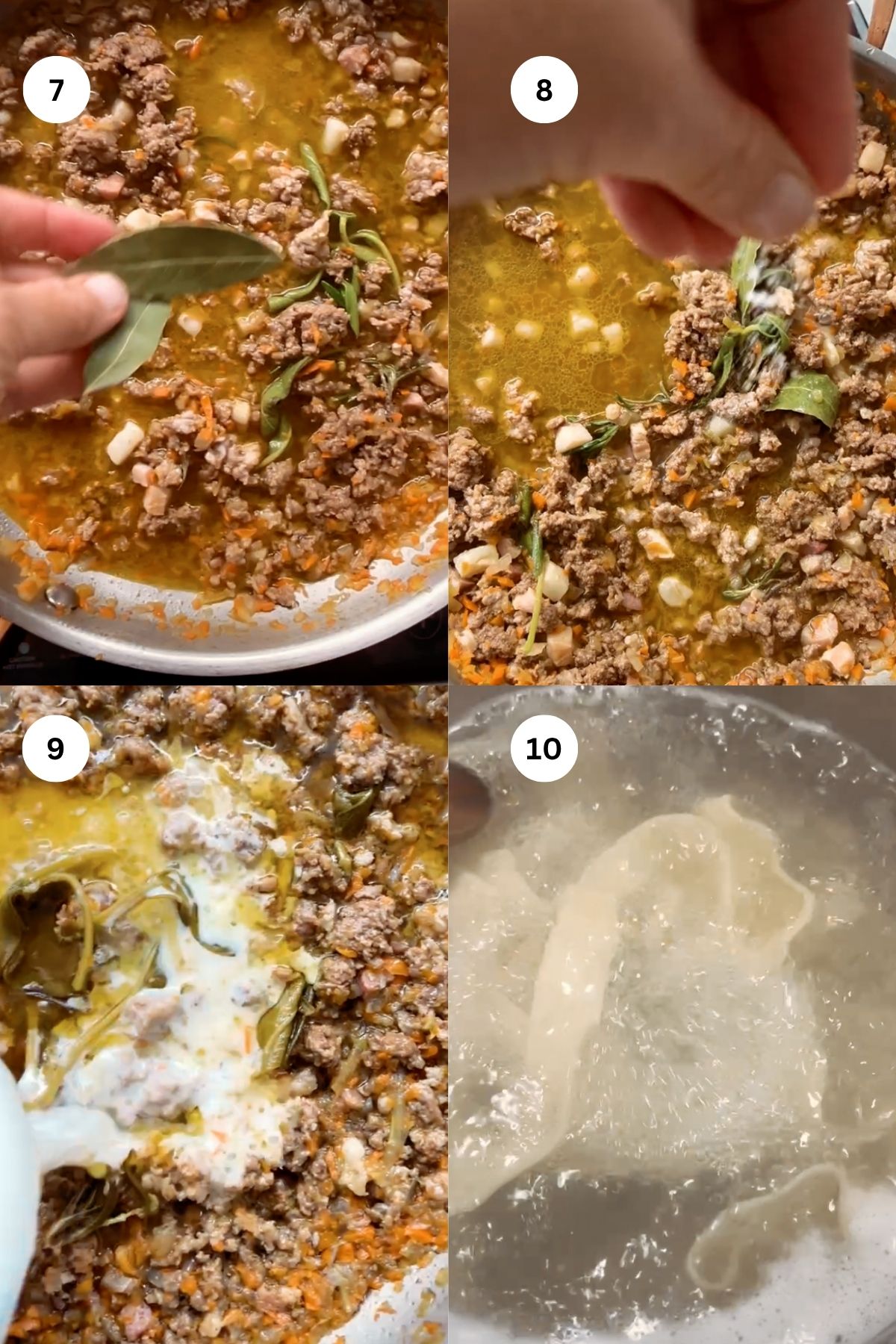
Freezing & Storing
- Refrigerate: Store in an airtight container for up to 3 days.
- Freeze: Freeze in portions up to 3 months. Thaw overnight, reheat with a splash of broth or milk.
- Reheat: Warm gently on the stove over low heat.

Serving Suggestions
- Toss with fresh tagliatelle or pappardelle
- Serve alongside a crisp arugula salad
- Pair with crusty bread and Parmesan shavings
- Enjoy with a glass of Soave or Pinot Grigio
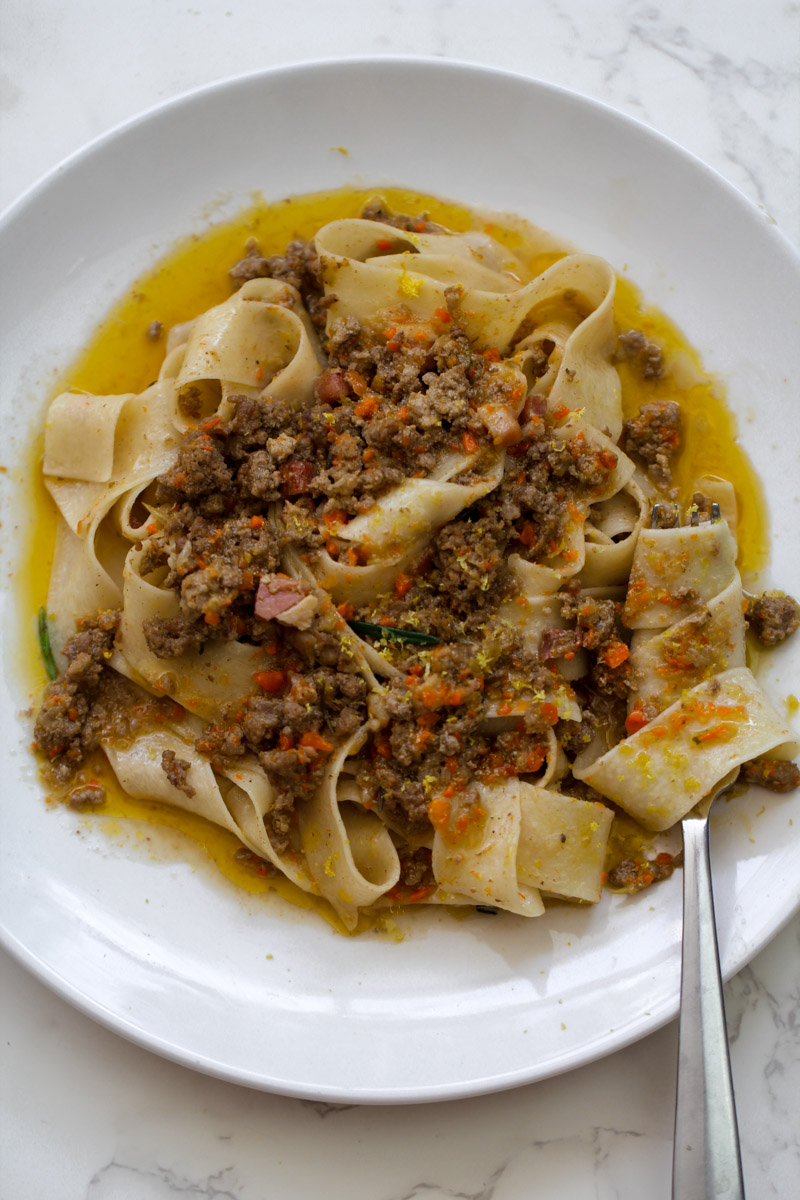
Pro Tips for the Best White Ragù
- Cook the soffritto slowly until golden — this is your flavor base.
- Deglaze with wine and let it reduce fully before adding broth.
- Simmer low and slow; ragù is about patience, not speed.
- Add milk at the end for silkiness without overpowering.
- Always finish with Parmesan — my husband insists it’s non-negotiable.
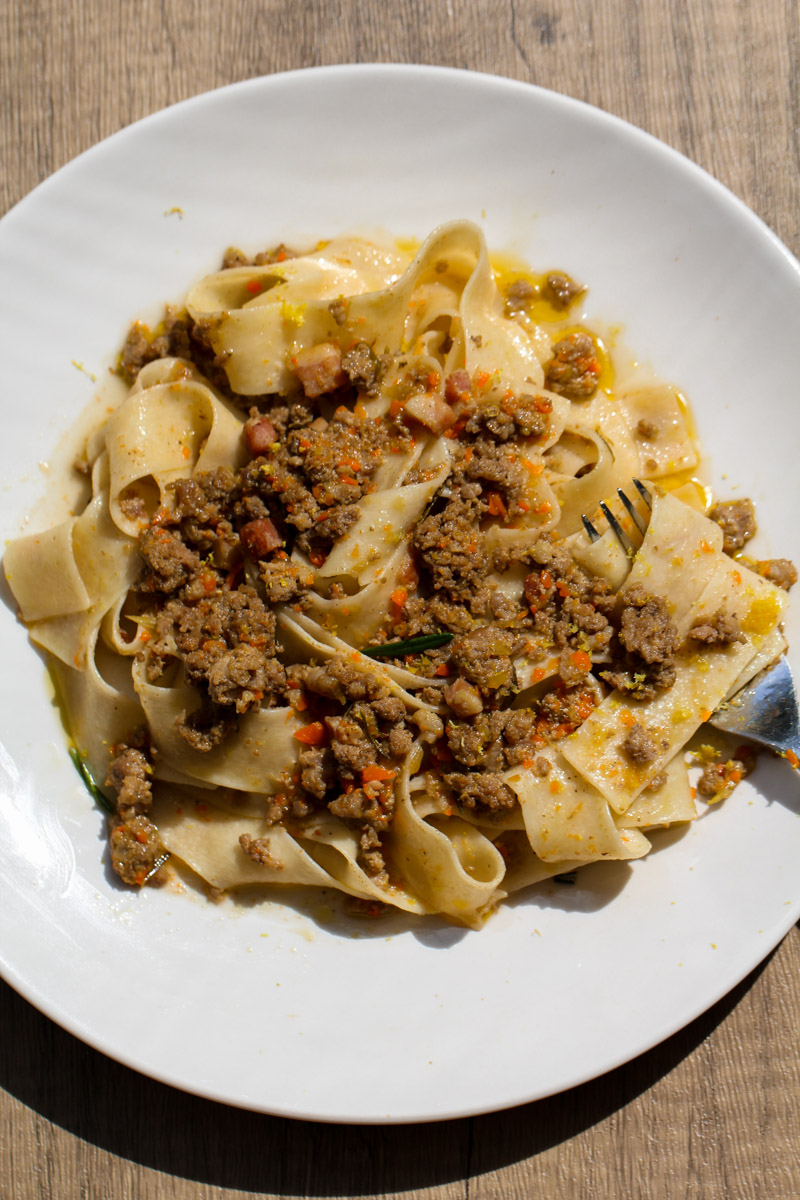
FAQ's
Ragù bianco is an Italian white meat sauce made without tomatoes. It’s typically made with ground veal, pork, or beef, soffritto (onion, carrot, celery), white wine, broth, and milk or cream.
Traditional Bolognese uses tomatoes for its base, while ragù bianco is tomato-free, relying on white wine and milk for richness. Both are slow-simmered sauces from Emilia-Romagna.
Wide, fresh egg pastas like tagliatelle, pappardelle, or fettuccine are traditional, but rigatoni, orecchiette, or gnocchi also work well.
Yes — it actually tastes better the next day. Store it in the fridge for up to 3 days or freeze in portions for up to 3 months.
A dry white wine like Pinot Grigio, Soave, or Verdicchio is perfect for cooking and serving.
Yes! This tomato-free white Bolognese comes from Emilia-Romagna and is considered a classic regional dish.
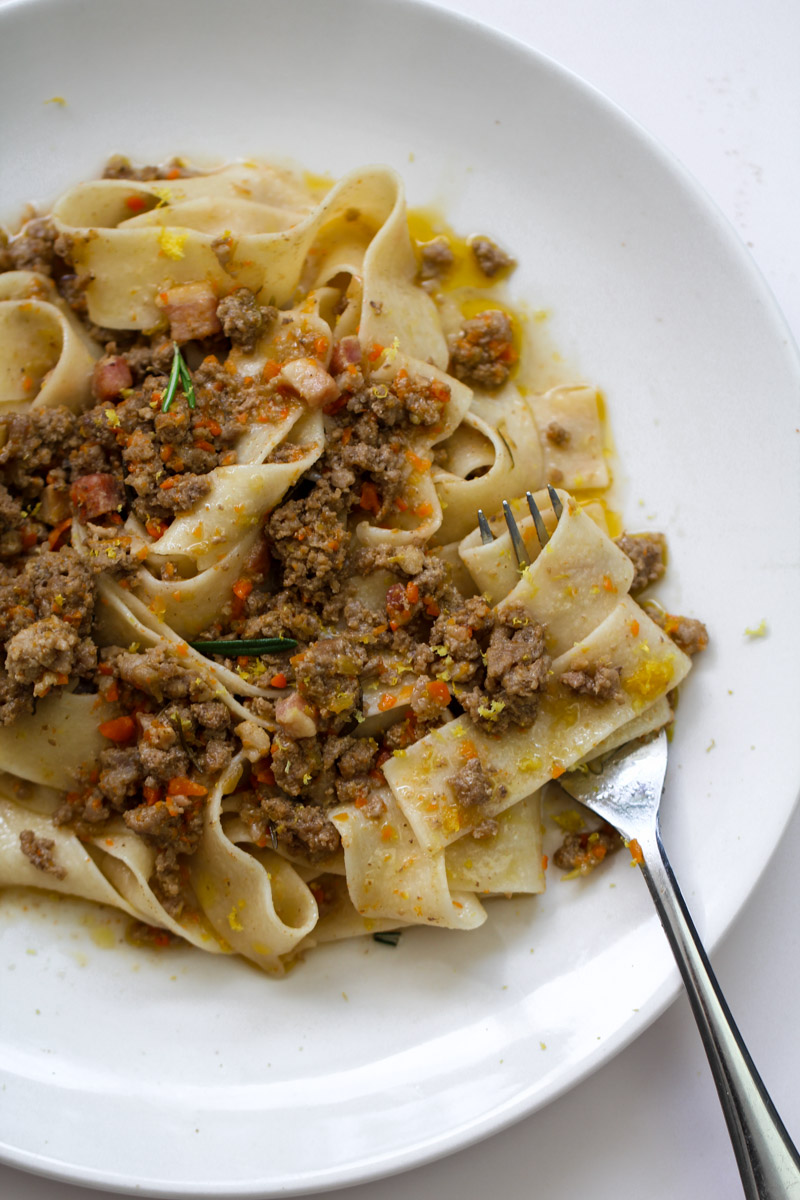
Serving Suggestions
- Toss with fresh tagliatelle or pappardelle
- Serve alongside a crisp arugula salad
- Pair with crusty bread and Parmesan shavings
- Enjoy with a glass of Soave or Pinot Grigio
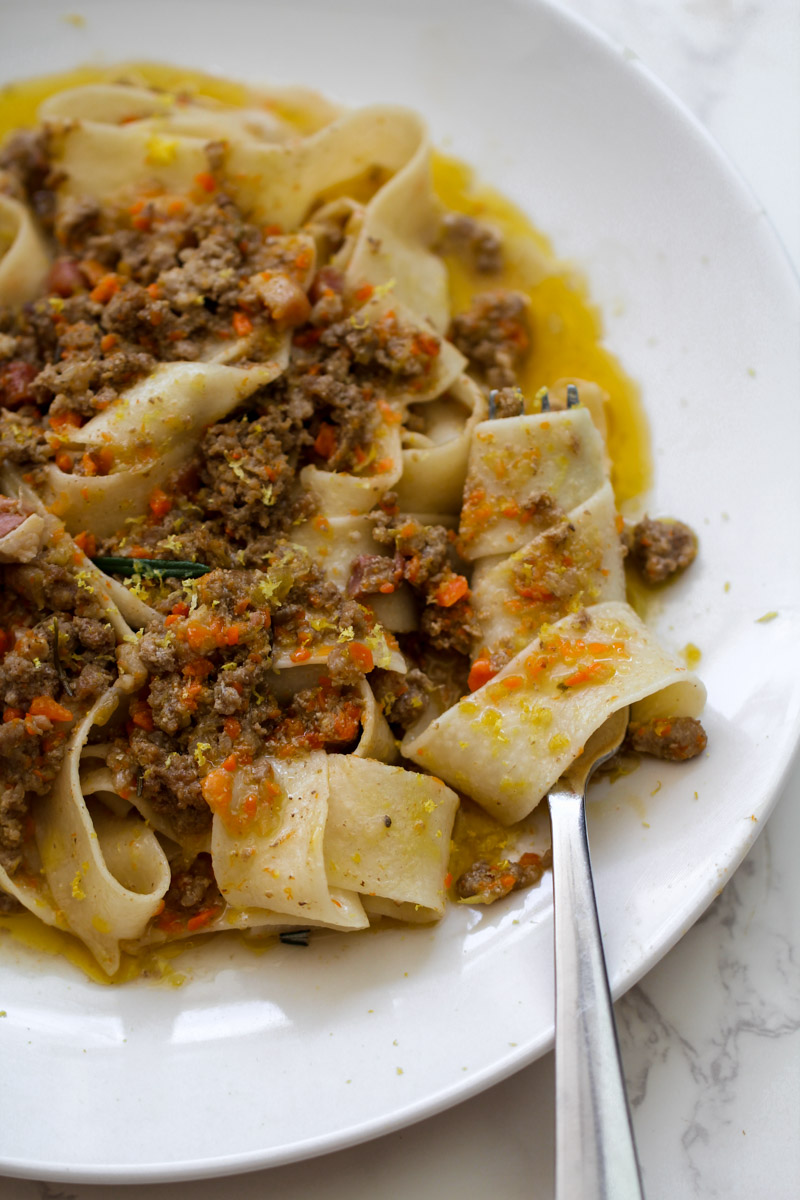
Some other recipes you'll love:
Did you make this and love it? Please RATE THE RECIPE below:)
I would LOVE IT if you could leave me a star rating and a review down below and let me know your thoughts! It means the world to me to hear how you liked it.
Please Subscribe and give a follow on Instagram, Facebook, Pinterest, and TikTok xx
📖 Recipe
📖 Recipe
Ragù Bianco (White Bolognese Sauce)
Equipment
- 1 large sauce pan
Ingredients
- 2 carrots peeled finely chopped (~ 1 cup)
- 2 celery stalks finely chopped (~ 1 cup)
- 1 medium onion finely chopped
- 2 ounces pancetta diced
- 1 pound ground beef chuck 20% fat you could also use ½ ground beef and ½ ground pork
- ⅓ pound pork sausage not spicy, casing removed
- ½ cup white wine a wine you would actually drink (your could use Rose' or even a Prosecco)
- 1 ½ cups unsalted chicken stock added in stage (use stock or broth-low sodium)
- 1 cup whole milk added in stages
- 1 teaspoon dried sage I used fresh sage from my garden
- 1 teaspoon dried rosemary I used fresh rosemary from my garden
- 1 dried bay leaf
- ¼ teaspon freshly ground nutmeg
- 1 teaspoon sea salt add more to your taste
- ½ teaspoon freshly ground black pepper add more to your taste
- lemon rind optional and if you do use, use organic
- 1 pound dried pasta such as pappardelle, tagliatelle, or rigatoni (fusilli or spaghetti could also work)
- Grated Parmigiano-Reggiano to serve
Instructions
Chop:
- To make the soffritto, add the chopped onion, celery, and carrot to a food processor and pulse until finely chopped. If you prefer, you can also chop everything by hand with a sharp knife.
Sauté
- In a medium size saucepan or a Dutch oven, heat the oil on medium heat. Add the soffritto (carrots, celery, and onions) and cook for about 7 minutes, until the vegetables soften (you aren't browning them). Add a pinch of salt and black pepper.
Pancetta
- If you would like to use diced pancetta, add that in now (totally optional). Keep stirring frequently.
Cook beef + sausage
- Add in the ground beef and sausage(you could do ground beef and ground pork). Break up any large lumps and cook until the meat is no longer pink, about 10 minutes.
Add herbs and season
- Add in the herbs and nutmeg (if you are using) and stir to combine. Season with salt and black pepper.
Reduce wine
- Add in the wine and stir to combine. Let the wine reduce.
Add milk + stock
- Add 1 cup of chicken stock (or broth) and about ⅓ cup milk. Cook over medium low heat until the sauce thickens, which could take about 1½ to 2½ hours stirring every 20 minutes. Make sure the sauce is not boiling, it's supposed to be a low simmer.
Season
- Check the flavor and season with a little bit more of salt and pepper, if needed. Don't forget to keep coming back to check the sauce and stir so the sauce doesn't stick to the bottom of the pan. Also, it may be thickening up and you'll have to add some water to it to loosen it up a bit. I simmer my ragu for about about 1½ to 2½ hours.
Simmer
- Simmer the sauce partially covered for about 30 minutes, giving it a stir once or twice as it cooks. If it starts to look a little dry, pour in a splash of the remaining chicken stock to keep it silky.
Add rest of stock + milk:
- Stir in the remaining chicken stock and an extra ⅓ cup of milk. Let it simmer for another 30 to 40 minutes, adding a splash of liquid as needed to keep the sauce creamy and thick—not dry and crumbly, but not too liquidy either.
Cook pasta
- Once the ragù has been simmering for 1 ½-2 hours, start cooking the pasta. Bring a large pot of well-salted water to a boil and cook the pasta al dente (check the timing on your pasta box and time it). Drain it, making sure to reserve some of the pasta water.
Add last bit of milk
- While the pasta cooks, stir the final ⅓ cup of milk into the ragù. Give it a good stir and taste for seasoning—I usually add a little more salt at this stage, if it's needed. You will be serving with Parmigiano Reggiano, so you don't want it too salty. Remove the bay leaf.
Optional:
- After you've added in the broth and milk, you could transfer the sauce to a slow-cooker and let it simmer on high for 3 hours or low for 6 hours.
Serve
- Combine the pasta with heated sauce. Be sure to stir and coat the pasta. ENJOY!
Nutrition Disclaimer
Please keep in mind that the nutritional information presented below is an approximation and may vary depending on the exact ingredients used.
Notes
- No tomatoes: Unlike traditional Bolognese, ragù bianco skips tomatoes entirely. The flavor builds from meat, soffritto, white wine, and stock, resulting in a delicate, savory sauce with a creamy finish.
- Meat matters: A mix of pork and veal (or pork and beef) gives the best depth. Some versions use sausage for extra richness.
- Low and slow: Gentle simmering is essential. Rushing the cooking won’t let the flavors meld properly. Aim for a soft burble, not a boil.
- Milk or cream: Adding a splash of milk toward the end softens acidity from the wine and gives the sauce its signature silky texture.
- Seasoning in layers: Salt the soffritto lightly, season the meat as it cooks, and taste again at the end. White ragù relies on subtle seasoning, so balance is key.
- Serving: It pairs beautifully with tagliatelle, pappardelle, or even baked into lasagna. Avoid strongly flavored pasta shapes that overpower the sauce.
- Storage: Ragù bianco tastes even better the next day. Store it in the fridge for up to 3 days or freeze it for up to 3 months.





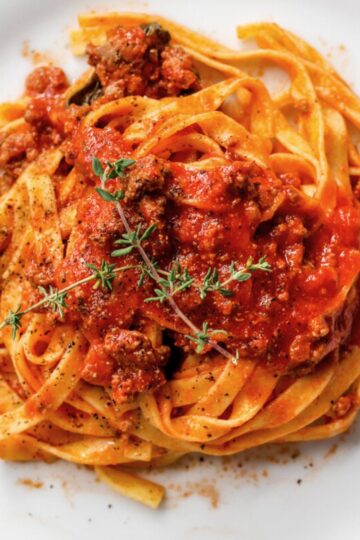
Jet says
Absolutely loved this take on white Bolognese. It's so rich and comforting without the tomatoes. The layering of flavors is just beautiful. Will try this soon!
Jen says
I'm making a big batch of this and freezing some so I can have it on hand. As someone that loves everything in bolognese sauce except the tomatoes, I'm so excited to find one that doesn't use tomatoes. I had no idea it was a thing!
Michele Peterson says
This white Bolognese sauce was such a welcome change from the usual tomato sauce. Definitely going to keep this recipe on repeat!.
Swathi says
This white sauce Bolognese is perfect with any pasta, I used simple one still tasted great.
Jaleah Kendrick says
This pasta is one of my favorites! It’s so good.